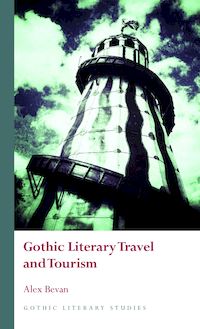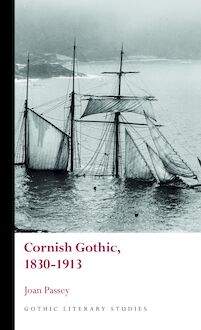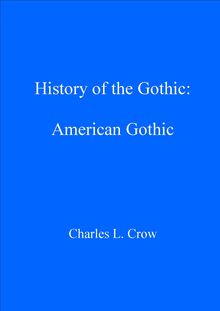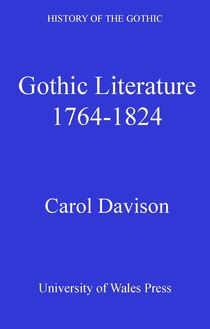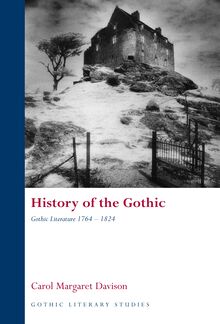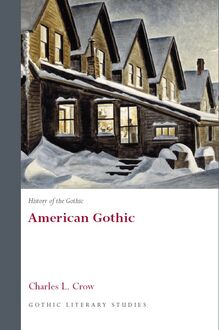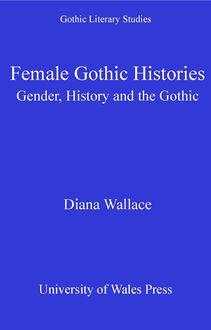-
 Univers
Univers
-
 Ebooks
Ebooks
-
 Livres audio
Livres audio
-
 Presse
Presse
-
 Podcasts
Podcasts
-
 BD
BD
-
 Documents
Documents
-
- Cours
- Révisions
- Ressources pédagogiques
- Sciences de l’éducation
- Manuels scolaires
- Langues
- Travaux de classe
- Annales de BEP
- Etudes supérieures
- Maternelle et primaire
- Fiches de lecture
- Orientation scolaire
- Méthodologie
- Corrigés de devoir
- Annales d’examens et concours
- Annales du bac
- Annales du brevet
- Rapports de stage
La lecture à portée de main
Découvre YouScribe en t'inscrivant gratuitement
Je m'inscrisDécouvre YouScribe en t'inscrivant gratuitement
Je m'inscrisEn savoir plus
En savoir plus

Description
1 Introduction 2. The Murder of the Mother: Sophia Lee's The Recess (1783-5) Coda: The daughter's story: Ann Radcliffe and the Female Gothic 3. Be-witched and Ghosted: Elizabeth Gaskell's Gothic historical tales 4. Puzzling over the Past: Vernon Lee's fantastic stories 5. Displacing the Past: Daphne du Maurier and the modern Gothic 6. Queer as History: Sarah Water's Gothic historical novels Afterword
Sujets
Informations
| Publié par | University of Wales Press |
| Date de parution | 15 mars 2013 |
| Nombre de lectures | 0 |
| EAN13 | 9780708325759 |
| Langue | English |
| Poids de l'ouvrage | 2 Mo |
Informations légales : prix de location à la page 0,2850€. Cette information est donnée uniquement à titre indicatif conformément à la législation en vigueur.
Extrait
Gothic Literary Studies
Female Gothic Histories
Gender, History and the Gothic
Diana Wallace
University of Wales Press
Demy cover Gothic Lit St template copy.indd 1 21/02/2013 15:46:18Demy cover Gothic Lit St template copy.indd 2 21/02/2013 15:46:18FEMALE GOTHIC HISTORIES
00 Prelims FemaleGoth 2013_2_12.indd 1 2/12/2013 10:37:49 AMSERIES PREFACE
Gothic Literary Studies is dedicated to publishing groundbreaking
scholarship on Gothic in literature and flm. The Gothic, which has
been subjected to a variety of critical and theoretical approaches, is
a form which plays an important role in our understanding of
literary, intellectual and cultural histories. The series seeks to
promote challenging and innovative approaches to Gothic which
question any aspect of the Gothic tradition or perceived critical
orthodoxy. Volumes in the series explore how issues such as gender,
religion, nation and sexuality have shaped our view of the Gothic
tradition. Both academically rigorous and informed by the latest
developments in critical theory, the series provides an important
focus for scholarly developments in Gothic studies, literary studies,
cultural studies and critical theory. The series will be of interest to
students of all levels and to scholars and teachers of the Gothic and
literary and cultural histories.
SERIES EDITORS
Andrew Smith, University of Sheffeld
Benjamin F. Fisher, University of Mississippi
EDITORIAL BOARD
Kent Ljungquist, Worcester Polytechnic Institute Massachusetts
Richard Fusco, St Joseph’s University, Philadelphia
David Punter, University of Bristol
Chris Baldick, University of London
Angela Wright, University of Sheffeld
Jerrold E. Hogle, University of Arizona
00 Prelims FemaleGoth 2013_2_12.indd 2 2/12/2013 10:37:49 AMFemale Gothic Histories
Gender, History and the Gothic
Diana Wallace
UNIVERSITY OF WALES PRESS
CARDIFF
2013
00 Prelims FemaleGoth 2013_2_12.indd 3 2/12/2013 10:37:49 AM© Diana Wallace, 2013
All rights reserved. No part of this book may be reproduced in any material
form (including photocopying or storing it in any medium by electronic
means and whether or not transiently or incidentally to some other use of
this publication) without the written permission of the copyright owner.
Applications for the copyright owner’s written permission to reproduce
any part of this publication should be addressed to the University of Wales
Press, 10 Columbus Walk, Brigantine Place, Cardiff CF10 4UP.
www.uwp.co.uk
British Library CIP Data
A catalogue record for this book is available from the British Library.
ISBN 978-0-7083-2574-2
e-ISBN 978-0-7083-2575-9
The right of Diana Wallace to be identifed as author of this work has been
asserted in accordance with sections 77 and 79 of the Copyright, Designs
and Patents Act 1988.
Typeset in Wales by Eira Fenn Gaunt, Cardiff
Printed by CPI Antony Rowe, Chippenham, Wiltshire
00 Prelims FemaleGoth 2013_2_12.indd 4 2/12/2013 10:37:49 AMContents
Preface vii
Acknowledgementsix
1Introduction 1
2The Murder of the Mother: Sophia Lee’s
The Recess (1783−5) 25
3 Be-witched and Ghosted: Elizabeth Gaskell’s
Gothic Historical Tales 67
4 Puzzling over the Past: Vernon Lee’s Fantastic
Stories 101
5 Displacing the Past: Daphne du Maurier and the
Modern Gothic 132
6 Queer as History: Sarah Waters’s Gothic Historical
Novels 163
Afterword 195
Notes197
Bibliography227
Index 243
00 Prelims FemaleGoth 2013_2_12.indd 5 2/12/2013 10:37:49 AM00 Prelims FemaleGoth 2013_2_12.indd 6 2/12/2013 10:37:49 AMPrefaCe
We need, as I argue in this book, a new theory of historical fction
and a meta-narrative of its development which takes more seriously
its intimate relationship with the Gothic. Such an account would
allow us more accurately to assess the contribution women writers
have made to the genre and, conversely, its central importance to
thinking about women and history. I use the term ‘historical fction’
deliberately here, rather than ‘historical novel’, because looking at
short fction problematises many of the assumptions frequently
made about both historical novels and the Gothic.
As I argued in The Woman’s Historical Novel: British Women Writers,
1900−2000 (2005), women’s historical fction has its roots in the
Gothic novel which precedes the work of Sir Walter Scott. Despite
evidence to the contrary, Scott is still commonly positioned as
the progenitor of the historical novel, even in such recent texts as
Jerome de Groot’s The Historical Novel (2010). Female Gothic Histories
extends the project of my earlier book in order to offer an
alternative account of historical fction as it has been developed and used
by women. It traces a female genealogy of Gothic historical fction
from Sophia Lee’s The Recess (1783−5) in the late eighteenth century
through the short fctions of Elizabeth Gaskell and Vernon Lee,
to the work of Daphne du Maurier which inspired the ‘modern
Gothics’ of the 1960s, and fnally to its most recent manifestation
in the hugely popular novels of Sarah Waters in the twenty-frst
century.
Such a long time span – covering two and a half centuries – offers
both benefts and problems. On the beneft side it provides a slice
of the ‘long history’ which historians such as Gerda Lerner and Mary
Beard have suggested is necessary if we are to understand what
1Beard called ‘woman as force in history’. Beard suggests in particular
00 Prelims FemaleGoth 2013_2_12.indd 7 2/12/2013 10:37:49 AMPreface
the need to go back beyond nineteenth-century ideologies which
so often shape our thinking about women. Indeed, I would argue
that one of the most valuable aspects of historical fction is precisely
its ability to direct our vision into the past, and to enable an
imaginative engagement with other possibilities.
On the other hand, such a long view creates real problems in an
age when academics are increasingly specialised. Given that my own
period specialism is the early twentieth century, it seems a dangerous
thing to strike back as far as the late eighteenth century. It is,
however, both important and invigorating to do such work. This book
is therefore indebted to the important work done by other feminist
literary critics on the beginnings of the historical novel, the national
tale and the Gothic in the late eighteenth and early nineteenth
century. Perhaps most importantly it builds on Ellen Moers’s eclectic
and innovative Literary Women (1976), written during the early years
2of ‘women’s liberation’. It was Moers who frst coined the term
‘Female Gothic’ and, although she did not discuss historical fction
as such, she was intensely aware of the importance of history: ‘If ever
there was a time which teaches that one must know the history of
3women to understand the history of literature’, she wrote, ‘it is now.’
The same is still true today and, despite its now well-documented
limitations and omissions, her ground-breaking work remains an
important inspiration.
Notes to the Preface
1 Mary R. Beard, Woman as Force in History (New York: Macmillan, 1946).
2 Ellen Moers, Literary W omen (1976; London: The Women’s Press, 1978).
3 Ibid., p. xiii.
viii
00 Prelims FemaleGoth 2013_2_12.indd 8 2/12/2013 10:37:49 AMaCknowledgements
This book has been a long time in the writing and I would like to
thank several colleagues and friends for their support and assistance.
Jane Aaron read most of the work in progress and has been a huge
source of support throughout. I am indebted to Jeni Williams, who
gave astute and tactful feedback on several chapters, and to Gavin
Edwards, Marion Shaw and Kevin Mills, who read individual chapters
and offered sage advice. I’d like to thank Meredith Miller for a
useful conversation about the ways in which the Gothic can be seen
as a kind of theory; Angela Wright for allowing me to see her work
in progress on Sophia Lee’s translation of Varbeck; Jonathan Durrant
for lending me books on witches; Rebecca Moore for conversations
about Daphne du Maurier; Linda Graves, Lesley Hargreaves and the
Inter-library loan team at the University of Glamorgan for their
patience and persistence in obtaining material; and Rhiannon Sargent
for support in the fnal stages. My students on The Female Gothic
and Gothic Histories modules at Glamorgan University have been
another source of inspiration. Thank you to Andrew Smith for
inviting me to contribute this volume to the series; to Sarah Lewis, who
has been an endlessly patient editor in the face of repeated delays;
and to UWP’s anonymous reader for her astute comments. I’d also
like to thank the postgraduates who organised the PGCWWN
Theory and Practice Networking day at Leicester University in
October 2010, and those who attended my workshop on historical
fction.
I am grateful to Sarah Waters and her literary agents, Greene &
Heaton, for kind permission to quote extracts from her novels,
Affnity © 1999, Fingersmith © 2002 and The Little Stranger © 2009;
to the Curtis Brown Group Ltd for kind permission to quote from
the novels of Daphne du Maurier: Jamaica Inn © 1936, Rebecca ©
00 Prelims FemaleGoth 2013_2_12.indd 9 2/12/2013 10:37:49 AMAcknowledgements
1938, The King’s General © 1946, My Cousin Rachel © 1951, Myself
When Young © 1977, The Rebecca Notebook: And Other Memories ©
1981; and to the Curtis Brown Group Ltd, London on behalf of
the Chichester Partnership, for kind permission to quote from the
Introduction to Northanger Abbey by Jane Austen © 1948.
Finally, my family have, as ever, been my biggest source of support
and encouragement, and I would like to thank my parents, Anne and
Nigel Wallace, my sisters, Linda Schjoett and Dawn Percival, and,
most of all, Jarlath and Seán.
00 Prelims FemaleGoth 2013_2_12.indd 10 2/12/2013 10:37:49 AMFor Jarlath and Seán
00 Prelims FemaleGoth 2013_2_12.indd 11 2/12/2013 10:37:49 AM00 Prelims Femal
-
 Univers
Univers
-
 Ebooks
Ebooks
-
 Livres audio
Livres audio
-
 Presse
Presse
-
 Podcasts
Podcasts
-
 BD
BD
-
 Documents
Documents
-
Jeunesse
-
Littérature
-
Ressources professionnelles
-
Santé et bien-être
-
Savoirs
-
Education
-
Loisirs et hobbies
-
Art, musique et cinéma
-
Actualité et débat de société
-
Jeunesse
-
Littérature
-
Ressources professionnelles
-
Santé et bien-être
-
Savoirs
-
Education
-
Loisirs et hobbies
-
Art, musique et cinéma
-
Actualité et débat de société
-
Actualités
-
Lifestyle
-
Presse jeunesse
-
Presse professionnelle
-
Pratique
-
Presse sportive
-
Presse internationale
-
Culture & Médias
-
Action et Aventures
-
Science-fiction et Fantasy
-
Société
-
Jeunesse
-
Littérature
-
Ressources professionnelles
-
Santé et bien-être
-
Savoirs
-
Education
-
Loisirs et hobbies
-
Art, musique et cinéma
-
Actualité et débat de société
- Cours
- Révisions
- Ressources pédagogiques
- Sciences de l’éducation
- Manuels scolaires
- Langues
- Travaux de classe
- Annales de BEP
- Etudes supérieures
- Maternelle et primaire
- Fiches de lecture
- Orientation scolaire
- Méthodologie
- Corrigés de devoir
- Annales d’examens et concours
- Annales du bac
- Annales du brevet
- Rapports de stage


